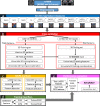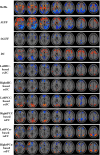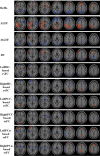Hybrid multivariate pattern analysis combined with extreme learning machine for Alzheimer's dementia diagnosis using multi-measure rs-fMRI spatial patterns
- PMID: 30794629
- PMCID: PMC6386400
- DOI: 10.1371/journal.pone.0212582
Hybrid multivariate pattern analysis combined with extreme learning machine for Alzheimer's dementia diagnosis using multi-measure rs-fMRI spatial patterns
Abstract
Background: Early diagnosis of Alzheimer's disease (AD) and Mild Cognitive Impairment (MCI) is essential for timely treatment. Machine learning and multivariate pattern analysis (MVPA) for the diagnosis of brain disorders are explicitly attracting attention in the neuroimaging community. In this paper, we propose a voxel-wise discriminative framework applied to multi-measure resting-state fMRI (rs-fMRI) that integrates hybrid MVPA and extreme learning machine (ELM) for the automated discrimination of AD and MCI from the cognitive normal (CN) state.
Materials and methods: We used two rs-fMRI cohorts: the public Alzheimer's disease Neuroimaging Initiative database (ADNI2) and an in-house Alzheimer's disease cohort from South Korea, both including individuals with AD, MCI, and normal controls. After extracting three-dimensional (3-D) patterns measuring regional coherence and functional connectivity during the resting state, we performed univariate statistical t-tests to generate a 3-D mask that retained only voxels showing significant changes. Given the initial univariate features, to enhance discriminative patterns, we implemented MVPA feature reduction using support vector machine-recursive feature elimination (SVM-RFE), and least absolute shrinkage and selection operator (LASSO), in combination with the univariate t-test. Classifications were performed by an ELM, and its efficiency was compared to linear and nonlinear (radial basis function) SVMs.
Results: The maximal accuracies achieved by the method in the ADNI2 cohort were 98.86% (p<0.001) and 98.57% (p<0.001) for AD and MCI vs. CN, respectively. In the in-house cohort, the same accuracies were 98.70% (p<0.001) and 94.16% (p<0.001).
Conclusion: From a clinical perspective, combining extreme learning machine and hybrid MVPA applied on concatenations of multiple rs-fMRI biomarkers can potentially assist the clinicians in AD and MCI diagnosis.
Conflict of interest statement
The authors have declared that no competing interests exist.
Figures






Similar articles
-
Mild Cognitive Impairment Diagnosis Using Extreme Learning Machine Combined With Multivoxel Pattern Analysis on Multi-Biomarker Resting-State FMRI.Annu Int Conf IEEE Eng Med Biol Soc. 2019 Jul;2019:882-885. doi: 10.1109/EMBC.2019.8857623. Annu Int Conf IEEE Eng Med Biol Soc. 2019. PMID: 31946035
-
Application of advanced machine learning methods on resting-state fMRI network for identification of mild cognitive impairment and Alzheimer's disease.Brain Imaging Behav. 2016 Sep;10(3):799-817. doi: 10.1007/s11682-015-9448-7. Brain Imaging Behav. 2016. PMID: 26363784
-
Predicting conversion from MCI to AD by integrating rs-fMRI and structural MRI.Comput Biol Med. 2018 Nov 1;102:30-39. doi: 10.1016/j.compbiomed.2018.09.004. Epub 2018 Sep 15. Comput Biol Med. 2018. PMID: 30245275
-
A survey on applications and analysis methods of functional magnetic resonance imaging for Alzheimer's disease.J Neurosci Methods. 2019 Apr 1;317:121-140. doi: 10.1016/j.jneumeth.2018.12.012. Epub 2018 Dec 26. J Neurosci Methods. 2019. PMID: 30593787 Review.
-
Diagnostic power of resting-state fMRI for detection of network connectivity in Alzheimer's disease and mild cognitive impairment: A systematic review.Hum Brain Mapp. 2021 Jun 15;42(9):2941-2968. doi: 10.1002/hbm.25369. Epub 2021 May 4. Hum Brain Mapp. 2021. PMID: 33942449 Free PMC article.
Cited by
-
Ensemble learning using traditional machine learning and deep neural network for diagnosis of Alzheimer's disease.IBRO Neurosci Rep. 2022 Sep 3;13:255-263. doi: 10.1016/j.ibneur.2022.08.010. eCollection 2022 Dec. IBRO Neurosci Rep. 2022. PMID: 36590098 Free PMC article.
-
Comparison of the diagnostic accuracy of resting-state fMRI driven machine learning algorithms in the detection of mild cognitive impairment.Sci Rep. 2023 Dec 14;13(1):22285. doi: 10.1038/s41598-023-49461-y. Sci Rep. 2023. PMID: 38097674 Free PMC article.
-
An Efficient Combination among sMRI, CSF, Cognitive Score, and APOE ε4 Biomarkers for Classification of AD and MCI Using Extreme Learning Machine.Comput Intell Neurosci. 2020 Jun 4;2020:8015156. doi: 10.1155/2020/8015156. eCollection 2020. Comput Intell Neurosci. 2020. PMID: 32565773 Free PMC article.
-
Artificial intelligence for brain diseases: A systematic review.APL Bioeng. 2020 Oct 13;4(4):041503. doi: 10.1063/5.0011697. eCollection 2020 Dec. APL Bioeng. 2020. PMID: 33094213 Free PMC article. Review.
-
fMRI-based Alzheimer's disease detection via functional connectivity analysis: a systematic review.PeerJ Comput Sci. 2024 Oct 16;10:e2302. doi: 10.7717/peerj-cs.2302. eCollection 2024. PeerJ Comput Sci. 2024. PMID: 39650470 Free PMC article.
References
-
- Braak H, Braak E. Neuropathological stageing of Alzheimer-related changes. Acta Neuropathol. 1991;82: 239–259. - PubMed
Publication types
MeSH terms
LinkOut - more resources
Full Text Sources
Medical

